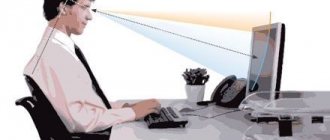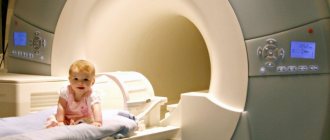Which specialists should you see for regular headaches?
If a person often has headaches, then you need to find out their nature. It is likely that this is vascular disease, fatigue, myopia or a tumor formation. A thorough examination will help identify the cause of pain impulses and provide treatment.
Diagnosing a patient begins with tests and a visit to specialized doctors: ophthalmologist, otolaryngologist, neurologist, dentist.
Neurologist
Which specialists should you see for regular headaches?
A neurologist is a specialist who diagnoses problems in the activity of the nervous system and blood vessels in the brain. If there is constant pain in the head, the doctor may prescribe the patient some types of examinations:
- encephalogram. It is performed for injuries, high blood pressure, cervical chondrosis, vegetative-vascular dystonia and sleep problems, which can cause headaches;
- CT scan. This type of diagnosis helps to see damage to the skull, areas of circulatory disorders in the brain, the presence of plaques in blood vessels, hydrocephalus, pathologies of brain functioning in children, the development of tumor processes;
- MRI is a modern and informative examination method that helps to see the most microscopic changes in the brain.
- angiography is a method of examining vessels after placing a diagnostic component in them. The component is placed into the venous bed under local anesthesia. The method is performed when other diagnostic methods are insufficient. Allows you to detect damage to blood vessels, disturbances in their development, and narrowing of the lumen.
Causes of headaches
The causes of cephalalgia can be divided into external and internal.
The first category includes factors not associated with any internal pathology that provoke headaches:
- peculiarities of climate, weather conditions (heat, cold, excess sun, changes in atmospheric pressure, etc.);
- clogged atmosphere (strong odors, fumes, fumes, toxins);
- noise pollution of the urban environment;
- reaction to certain foods, alcohol;
- physical and mental fatigue;
- bright lights, flashing lights, etc.
1 Headache. Diagnosis and treatment
2 Traction therapy
3 Headache. Diagnosis and treatment
The second group includes cephalgia associated with various diseases.
So, headaches can be caused by:
- Diseases affecting the brain: inflammatory diseases (meningitis, encephalitis, etc.);
- head injuries (traumatic brain injuries, concussions, etc.);
- tumor neoplasms.
- viral and bacterial infections that occur with increased temperature;
Introduction
Headache is among the most common reasons for patients seeking outpatient care. Tension headache (TTH) and migraine occur in more than 90% of the total number of patients suffering from headaches, and occupy second and third place in prevalence, second to dental caries. Migraine ranks seventh in the world among the causes of disability.
Tension headache occurs in 38% of the population, migraine in 10%, chronic daily headache (includes chronic daily tension headache, daily migraine) in 3% (Stovner L, Hagen K, 2007), and cervicogenic headache in 2.5– 4.7% (Haldeman S, Dagenais S. 2001, Sjaastad O, Bakketeig LS. 2007).
General algorithm for examining a patient with headache
While for patients with rare attacks of headaches, a one-time use of over-the-counter painkillers is sufficient, for patients with chronic daily headaches, painstaking work is required: examination to determine the type of headache, selection of preventive treatment, supportive measures aimed at lifestyle correction , developing the skill of identifying and correcting inadequate reactions to stress, as well as eliminating associated disorders (insomnia, anxiety, depression).
The term “chronic daily headache” (CDH) refers to primary headaches that the patient experiences at least 15 days a month, at least 4 hours a day, for at least 3 months in a row.
Differential diagnosis of CEHD requires following a certain algorithm. Initially, the case is assessed for “red flags” to identify patients with possible secondary headaches. After excluding secondary headaches, the clinical picture of which is similar to CEHD, headaches are divided into groups according to the duration of attacks. When attacks last <4 hours, trigeminal autonomic cephalgia (TVC) and hypnic headache are most likely to occur. If headache duration is ≥4 hours, the differential diagnosis includes chronic migraine, chronic tension-type headache, new daily (initially) persistent headache, and hemicrania continua.
Figure 1. Algorithm for diagnosing the type of headache
Secondary headaches with similar clinical manifestations to benign cephalgic syndromes:
- headache associated with vascular diseases;
- headache due to cerebrovascular diseases, including carotid artery dissection and arteriovenous malformations;
- arteritis, including giant cell arteritis;
- headache associated with non-vascular types of intracranial pathology;
- headache associated with low cerebrospinal fluid pressure (spontaneous or post-traumatic leakage of cerebrospinal fluid);
- headache associated with increased cerebrospinal fluid pressure without papilledema;
- intracranial pathology: Lyme disease, HIV, encephalitis, fungal meningitis, etc.
- headache associated with drug abuse or withdrawal;
- abuse of drugs to relieve headaches (withdrawal syndrome or toxic effects of drugs when abused);
- headache associated with damage to the skull, cervical spine, eyes, ears, nose and paranasal sinuses, teeth, oral cavity or other structures of the facial and cerebral skull;
- diseases of the ENT organs, including chronic sphenoiditis (or damage to other paranasal sinuses);
- pathology of the nasopharynx, including malignant neoplasms;
- pathology involving the branches of the trigeminal nerve, including diseases of the teeth and oral cavity, lower jaw;
- subacute pain associated with angle-closure glaucoma, optic neuritis and other pathologies of the visual organs;
- pathology of the craniovertebral junction, including Chiari malformation type I; pathology of the joints, roots or nerves of the upper cervical segments, including neuralgia;
- headache associated with extracranial infectious diseases, metabolic or systemic diseases: hepatitis, kidney disease, vitamin B12 deficiency, anemia, the effects of carbon monoxide and other toxins;
- headache associated with hormonal disorders/endocrinological diseases (disorders of estrogen metabolism, thyroid diseases, hyperprolactinemia, etc.);
- headache associated with vasculitis/rheumatism and other diffuse connective tissue diseases;
- mixed causes of headache;
- headache associated with pathology of the chest and mediastinum, including angina pectoris, mass formations, superior vena cava syndrome.
Figure 2. Algorithm for the distribution of primary headaches by frequency and duration
Figure 3. Types of primary headache of short duration
Figure 4. Types of primary headache of long duration
Anamnesis
In most cases, headaches are not associated with any structural damage to the brain. Modern research methods, unfortunately, do not help in establishing a diagnosis. Therefore, it is extremely important to collect complaints and anamnesis from patients and their relatives.
A set of questions for collecting anamnesis in a patient with headache
- When did the headaches start? How long do the pain attacks last?
- What is the frequency of headache attacks (how many times per month/day/week/year)?
- At what time of day do headaches most often develop?
- What causes headache attacks?
- What intensifies an attack and what helps to stop it?
- What reduces headaches (treatment, rest, sleep)?
- Specify the symptoms (precursors) that precede an attack of pain (if any)?
- How does a headache attack begin and how does it stop (describe the change in intensity and nature of the headache during the attack)?
- In what areas of the head do you feel pain?
- Where does it spread (to other areas of the head, neck, eye, jaw)?
- Do you have a constant or paroxysmal headache?
- What is the nature of the pain: dull/sharp, constant/pulsating, what local sensations is it similar to (stabbing, pressing, cutting, burning)? How intense is the headache (assessed using a visual analogue scale - VRS)?
- Describe the accompanying symptoms during the attack (nausea, double/blurred vision, convulsions, loss of consciousness)?
- How do you behave during an attack (as usual/trying to reduce activity/throwing around in pain)?
- What medications, when and for how long have you taken to treat headaches and what was the effect?
- Do your close blood relatives suffer from similar attacks.
Determination of indications for neuroimaging. SNOOP 4 algorithm
To select patients for neuroimaging studies, a diagnostic algorithm is widely used in English-speaking countries, which is designated by the acronym SNOOP 4 (to snoop).
Below is its Russian-language analogue NSAID 5-3-1-2.
Table 2. Algorithm for determining indications for neuroimaging for headache NSAIDs 5-3-1-2
| H (5) | ||
| New headache (new headache or change in the nature of an old one) | Yes | No |
| Unexpected onset (acute or sudden) | Yes | No |
| Onset of headaches after age 50 | Yes | No |
| Onset of headaches during pregnancy or after childbirth | Yes | No |
| Neurological disorders (impaired vision, hearing, smell, consciousness, thinking; numbness and/or weakness of the limbs) | Yes | No |
| P (3) | ||
| Constant (or daily) | Yes | No |
| Progressive (increases over time) | Yes | No |
| Positional (appears or intensifies with certain head positions) | Yes | No |
| IN 1) | ||
| Caused by Valsalva conditions (coughing, sneezing, straining, bending the body forward, squatting, rising from a squat) | Yes | No |
| C (2) | ||
| Systemic symptoms (fever, weight loss) | Yes | No |
| Systemic disease (known malignant tumor, including malignant or previously benign tumor of the hematopoietic organs; HIV infection) | Yes | No |
| Compliance with any of the criteria (“red flags”) indicates a possible connection of the headache with organic brain damage (primarily with a space-occupying lesion). A patient with one or more positive responses requires neuroimaging |
Table 3. Red flags, suspected conditions, and investigations for headaches
| Red flags" | Estimated condition | Research |
| Acute sudden onset of headache | Subarachnoid hemorrhage, hemorrhage into a tumor or AVM, mass formation (especially of the posterior fossa) | Neuroimaging, lumbar puncture (after neuroimaging) |
| Progressive worsening headache | Mass formation, subdural hematoma, drug abuse | Neuroimaging |
| Headache in patients with cancer, HIV, or systemic symptoms (fever, neck stiffness, skin rash) | Meningitis, encephalitis, Lyme disease, systemic infection, connective tissue diseases (collagenoses), arteritis | Neuroimaging, lumbar puncture, brain tissue biopsy, laboratory blood tests |
| Focal neurological symptoms or symptoms other than those characteristic of the visual or sensory aura | Mass formation, AVM, connective tissue diseases (collagenosis) | Neuroimaging, examinations to exclude connective tissue diseases |
| Papilledema | Mass formation, pseudotumor, encephalitis, meningitis | Neuroimaging, lumbar puncture (after neuroimaging) |
| Caused by Valsalva conditions (coughing, sneezing, straining, bending the body forward, squatting, rising from a squat) | Subarachnoid hemorrhage, mass formation | Neuroimaging, consider lumbar puncture |
| Headache during pregnancy and after childbirth | Thrombosis of intracranial sinuses or cortical veins, pituitary apoplexy | Neuroimaging |
No reason to worry
Many people simply do not know in what cases they should seek emergency medical help, and therefore call an ambulance for any trifle.
Sometimes they even make a fuss and demand that someone come to them and do a routine injection or bandage - that is, a procedure that is done in a clinic at their place of residence. Therefore, first we will name a range of situations in which the ambulance should not be disturbed. So, the ambulance does not leave:
● to carry out scheduled appointments of the local doctor (injections, IVs, dressings, etc.) or to issue certificates and ballots; ● in case of exacerbation of chronic diseases (if the patient’s condition does not require emergency medical care); ● to provide dental care; ● for intrahospital transportation; ● for transporting the deceased to the morgue.
Types of headaches
According to the WHO classification, it is customary to distinguish the following types of cephalalgia:
- Migraine;
- Tension headache (TTH);
- Cluster headache (CHH);
- Drug overuse headache (DOH).
Migraine
Migraine is familiar to every tenth adult inhabitant of the planet. Two out of three patients suffer pain on their legs, although their quality of life and performance are significantly reduced, but every third person is put to bed by an attack.
The disease is characterized by recurrent attacks (often throughout life), and episodes can be repeated at intervals from once a year to once a week.
As a rule, a person encounters migraine for the first time during puberty (although migraine attacks also occur in children), and the disease reaches its “heyday” when the patient is between the ages of 35 and 45. Women suffer from this disease twice as often as men, which is explained by hormonal reasons.
Migraine may be accompanied by an aura (auditory, visual and other sensations that precede pain), or it may begin without any preliminary signs.
1 Manual therapy
2 Traction therapy
3 Neurology
Migraine symptoms:
- persistent headache (a migraine attack can last from a couple of hours to several days), aggravated by physical activity;
- intolerance to noise, bright light (color), intolerance to smells and vibrations;
- throbbing, often one-sided pain radiating to the eye socket (this is a characteristic pain in migraine);
- irritability, lack of coordination;
- drowsiness due to inability to sleep due to pain;
- nausea, vomiting;
- chills, palpitations, sweating, shortness of breath;
- lack of appetite.
The causes of migraine, unfortunately, are still not known for certain. Scientists believe that heredity, as well as vascular, neurochemical and neurogenic factors, are largely to blame for the occurrence of the disease.
In search of a cure for migraine, many patients randomly and uncontrollably take various painkillers. This should not be done! Only an appropriately qualified specialist can choose the appropriate tactics for treating migraine!
Tension headache (TTH)
This is one of the most common types of headaches. Almost every second inhabitant of the planet complains of periodic attacks of tension-type headache (less than 15 days a month); Chronic tension-type headache affects up to 3% of adults.
TTH usually begins during puberty and is more common in women.
The duration of an episode of episodic TTH can be measured in either hours or days (less commonly). Chronic tension-type headache can torment the patient almost continuously, poisoning his life and reducing his ability to work.
Patients characterize tension headaches as squeezing headaches. Sometimes these sensations also affect the neck.
Cluster headache (CHH)
A rather rare type of headache: it affects less than one person in a thousand, and more often affects adults. The disease can be episodic or chronic.
KGB is characterized by frequent and short-lived, but very severe attacks. Typically, the pain is “based” in the eye area and is associated with redness, lacrimation and even drooping eyelids.
Drug overuse headache (DOH).
This is the so-called secondary type of headache, which occurs due to the constant and excessive use of drugs for headache of the primary type (i.e., migraine, tension-type headache, CBG).
GBL mainly affects women. The prevalence of the disease reaches 7% in some population groups.
Headaches caused by overuse of medications are described by patients as persistent, squeezing, and pressing. Often the attack begins during sleep and continues upon awakening.
Regular severe headaches of any type are a serious reason to consult a neurologist.
1 X-ray
2 Headache, diagnosis
3 MRI of the brain








